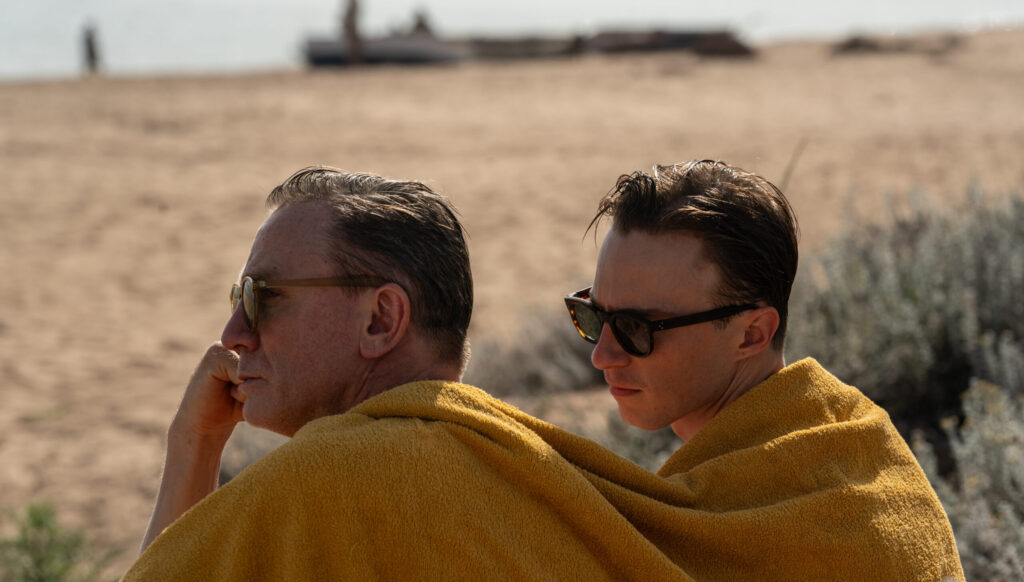
Behind the Scenes of Luca Guadagnino’s Queer Mexico Odyssey
From Luca Guadagnino (Call Me By Your Name) comes Queer, another international story of tenuous attraction, sex, and love between two American expats, this time in midcentury Mexico City.
Based on William S. Burroughs’ 1950s novel of the same name (but published in 1985), Queer stars Daniel Craig as Burroughs’ fictional alter ego William Lee, a disheveled and lonely writer who falls in love at first sight with Oklahoma tourist Eugene Allerton (Drew Starkey, Outer Banks). The story takes place against the backdrop of Latin America, as Lee struggles with his addictions, with winning Allerton’s companionship—and more. Burroughs began writing Queer in 1951, documenting (and fictionalizing) his stint as an expat in Mexico City, where he escaped in the 1940s to explore his sexuality and maintain his heroin addiction.
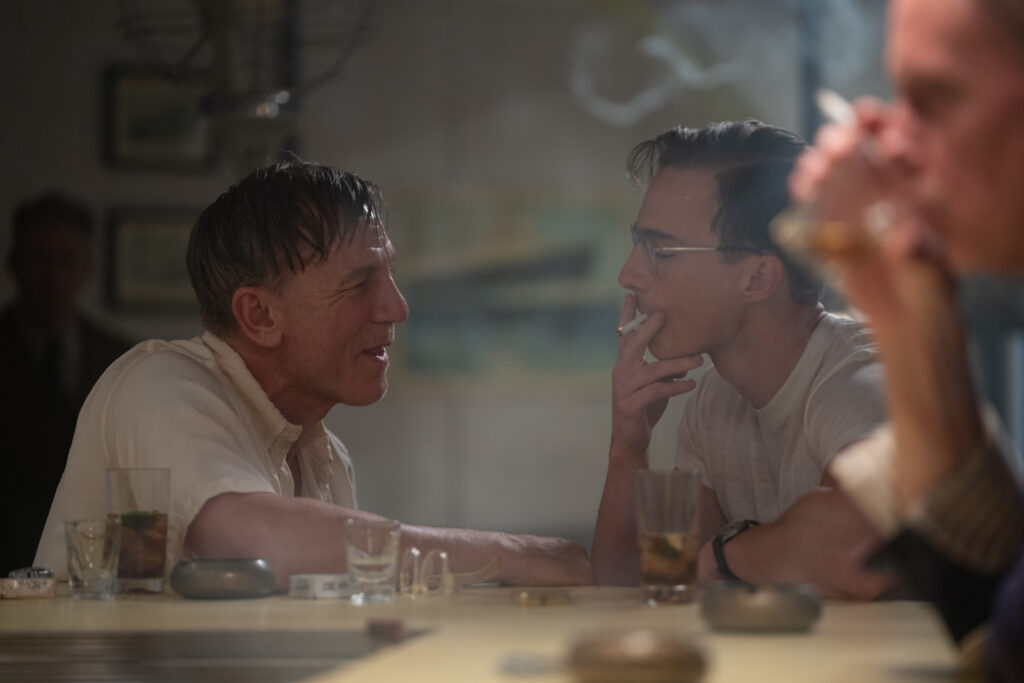
Queer was published long after Stonewall and ‘gay liberation’ had become a movement. But Burroughs rejected the LGBTQ community as an entity or identity. “I have never been gay a day in my life and I’m sure as hell not a part of any movement,” he declared. Nevertheless, he went on to influence many queer-minded and queer-adjacent artists, including John Waters, David Bowie, Patti Smith, and Kurt Cobain, who saw the gun-toting, suit-wearing junkie as the OG punk outsider.
On queerness, chemistry and human connections
Queer unites Guadagnino with his collaborators, including cinematographer Sayombhu Mukdeeprom and production designer Stefano Baisi who were both instrumental to bringing the vision to life.
“What connected me to [the novel Queer] was something I could feel within myself at the time: the idea of craving contact with somebody who reflects you, who you connect with on the deepest conceivable level,” says Guadagnino.
Lee’s character is dark, cynical, and twisted, and yet he yearns for a genuine romantic connection with another man. Amid all the explorations of how to embody gay love at a time when it is forbidden, it is also a metaphysical search. Lee’s main quest, parallel with the pursuit of Allerton, is to obtain some ayahuasca, a hallucinogenic botanical. He convinces Allerton to accompany him to the jungle, and they take the drug together in a ceremony presided over by the demented Dr. Cotter (Leslie Manville).
In the role of Lee, Daniel Craig, who Guadagnino had met 20 years ago, displays his signature combination of unassuming grace and unexpected awkwardness. The meet-cute between Lee and Allerton occurs as the men make eye contact above the heads of punters in a cockfight in a Mexico City street after dark. It’s a menacing, magnetic, and mirroring moment of encounter with the ‘other’.
Craig said what drew him to the project aside from working with Guadagnino was that he was offered a character who was “properly complicated. This really embodied someone who I thought was many things, all of which were fascinating to me, all of which I thought I could key into and it’s rare that you get a chance to do a character as layered as this.”
To get the character of Lee “deeply embedded” within him, Craig did various preparations and worked with an acting coach and a dialect teacher. Craig says he “could never really know” what it was like for Lee to be trying to find same-sex love at a time when it was illegal. “All I can do is try to do it justice.”
“Daniel is an amazing performer and an incredible artist who wasn’t at all intimidated by the material, and we agreed immediately that he should pay homage to William Burroughs in the most romantic way he possibly could, with warmth, openness, and total self-giving,” says Guadagnino. “Daniel dismantles Lee’s armor, piece by piece and beat by beat, and we’re left with the very moving experience of watching an anguished man in his search for love.”
“It’s an important part of my job to remain open and receptive, or I’ll miss something, and that would be sad,” says Craig, whose chemistry with the boyishly appealing and threatening Starkey is incredible.
Guadagnino brought Craig and Starkey together for a preliminary meeting in what he laughingly calls a “lovely threesome” — after which time the director left the actors alone to bond on their own. “We just hung out,” says Craig of his co-star. “Drew is such a delightful human being who is incredibly serious about his work, and I find it easy to respond and work with people who are like that.”
Adds Starkey: “We talked a lot, but didn’t dive into how the relationship between Lee and Allerton worked — the push and pull, the games the two play during their courtship,” focusing instead on how they would move and respond to one another.
Guadagnino connected Craig and Starkey with famed choreographers Sol Léon and Paul Lightfoot of the Nederlands Dance Theater for movement training to prepare them for a climactic scene where the lovers take ayahuasca together.
“We worked with these incredible choreographers for dance and movement rehearsals that continued weekly after we were in production in Italy,” says Starkey. “It was a very tactile practice — the most explorative I’ve ever felt preparing for a role — and so much of that work trickled into scenes in the movie that weren’t dance-oriented. Lee and Allerton’s chemistry is mostly unspoken, so it helped us open ourselves to the way two bodies can move in tandem with each other.”
It’s just moviemaking — but finding the reality of the scene and getting rid of the artifice also helped us. At the heart of it, this is two people who are into each other simply by being together. They’re not doing it for an audience, they’re doing it for each other.” —Daniel Craig
The actors prepared for months for the ayahuasca dance, which took 10 hours to film on a backlot at Cinecittà Studios in Rome.
“They danced, we filmed, I just followed them,” says Guadagnino. “Sol and Paul built this incredible scene around their concept of the fusion of love. External factors created the chemistry you see on screen between Daniel and Drew — but it was the actors’ sensitivity, intelligence and openness that fueled this chemistry.”
The movement work also helped open their minds for two intimate and explicit love scenes that play out over the course of the film, one in Mexico City during their courtship, and another in South America on their way to the jungle. The pair worked with an intimacy coordinator to help shape the scenes but relied on the bond they had built themselves.
“Shooting sex scenes for me is like filming somebody drinking a cup of tea, but sometimes it can be difficult for the actors,” says Guadagnino. “When you work with people like Daniel and Drew, and Omar Apollo, who appears in an early sex scene with Daniel Craig, you’re dealing with laid-back and humorous people who also happen to be committed artists.”
“I’m kind of a tight-assed Englishman and Luca is Italian and North African and very free,” says Craig. “He just allowed me to relax in a way that I’ve never experienced on a movie set before. It was important to keep it light, but it was about falling in love, and the tenderness that goes with that. The fact that we were able to laugh a lot between takes made a huge difference.”
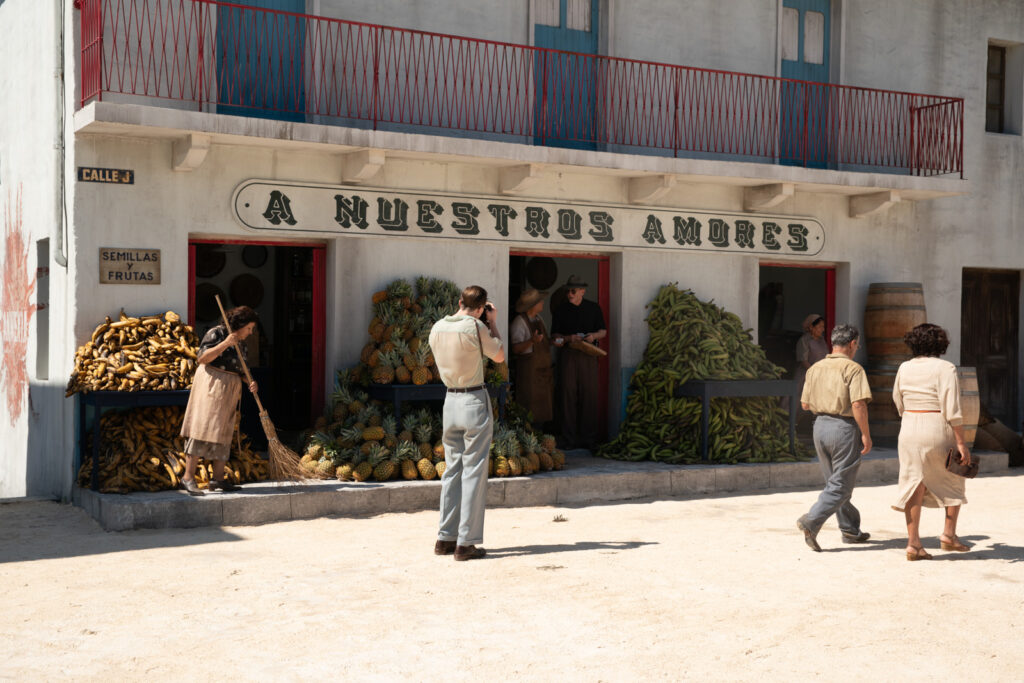
On place, locations, and psychology
Set in 1950s Mexico City and South America, Queer’s filming locations included Cinecittà Studios, Rome, Italy, Lazio, Italy, Quito, Ecuador (stand-in for Mexico City), and Mexico City, Mexico.
While the book is mostly set in a Mexico City bar where an enclave of gay expats gather to drink and dish, and then moves onto a South American fishing town and a jungle, it’s somewhat surprising that Queer was filmed almost entirely at Cinecittà Studios in Rome. This was a deliberate choice of the director. Guadagnino recently told the press that he had read the novel in Palermo when he was a young man aged 21 and wrote a screenplay adaptation, which he imagined would be shot entirely in a studio.
One of Guadagnino’s lifelong goals as a filmmaker has been to direct a feature film at Cinecittà Studios, the legendary 99-acre production facility in Rome where more than 3,000 movies have been shot since it opened in 1937, including works by Fellini, Rossellini, Visconti, Leone, Bertolucci, Coppola, and Scorsese.
When he was writing his early draft of Queer as a young man, Guadagnino knew the eventual movie he was going to make had to play out as a projection of the fantasies of Burroughs, as revealed in his novel and subsequent works. Therefore, filming Queer on location in Mexico City or the Ecuadorian jungle for the sake of “realism” was never an option.
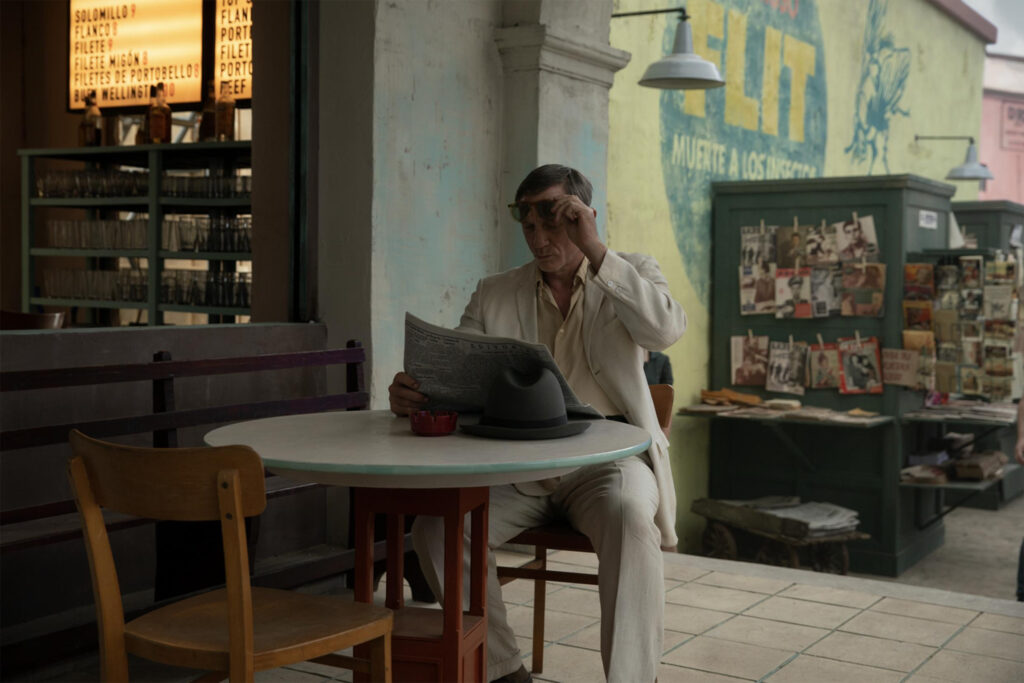
Guadagnino explained the choice to shoot largely in Rome: “The movie was supposed to be made as a sort of rendering of the imagery of William Burroughs. In the book, he describes places that might have been real places in his experience in Mexcity City, brings memories of other places and even creates fantasy places that are within the geography of Mexcio City and South America.”
When it came to the production design for the movie, the idea was instead of making a period drama set in real locations, they would “create the reality of the Imaginarium of Burroughs.”
Guadagnino says his production designer Stefano Baisi mimicked Burroughs’s literary technique of bricolage to represent Lee’s struggle in finding belonging. Baisi wanted “different styles for the way in which the buildings behaved, from modernism to colonialism, including some of the landmarks of Mexico City… and then created a juxtaposition of buildings and spaces so that it becomes the phantasmagorical world of Burroughs.
A scene where Lee travels to a greenhouse for advice from a botanist on how to find ayahuasca was filmed in the botanical gardens in Palermo. The scenes in the jungle were created by Baisi in the backlot of Cinecittà Studios. Many exotic live plants were flown in from Sicily and blended with fake plants and some digital extensions. The resulting visual effect is a convincingly chaotic psychological landscape rather than a real one.
“Thirty years after I started thinking about the novel as a movie, I was still committed to the idea of recreating Mexico City, Panama City and Ecuador as if these were artificial places reflecting the anguish and desire and imagery of Burroughs’ source material,” says Guadagnino.
For production designer Baisi, the world of Queer was built at Cinecittà through a combination of color, texture, and scale. After reading Burroughs’ novel, Baisi, who is a trained architect, was struck by its raw, dreamlike nature, and the way its author explores the theme of desire. “The importance Luca gives to the design in all his projects is very high, extending to any set or location where the camera travels,” says Baisi. “Every single detail has to be meticulously designed because Luca is very precise.”
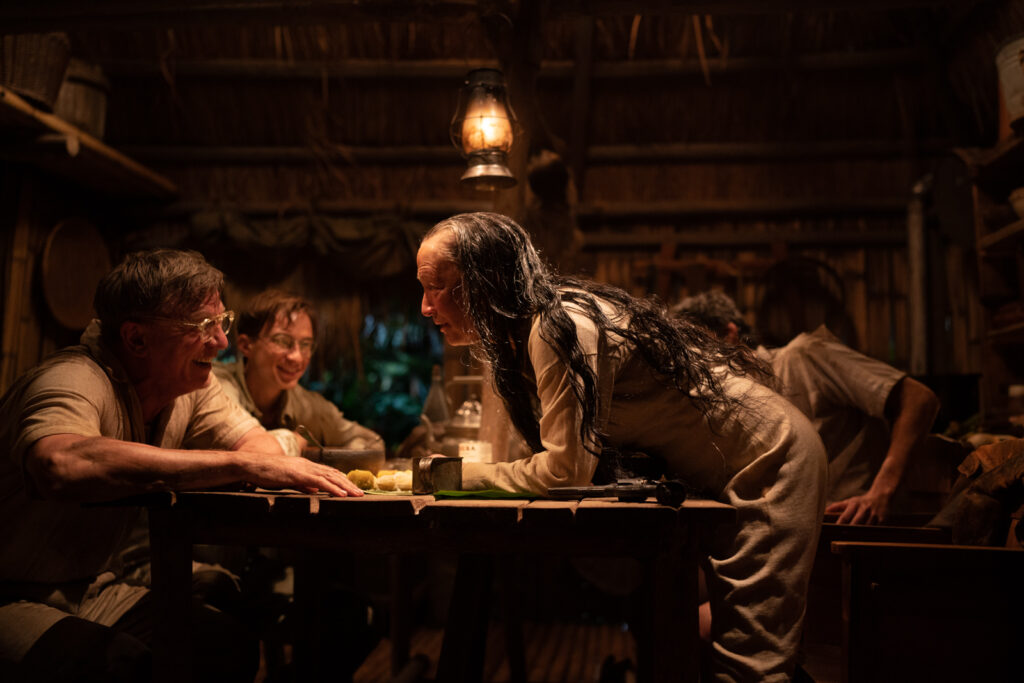
Baisi researched each location in the three distinct chapters and locales that divide Justin Kuritzkes’ script: Mexico City, the South American jungle, and Quito, Ecuador. Everything in Queer, including the jungle scenes that play out in the film’s third chapter, were constructed and filmed inside Cinecittà in late 2023.
For the Mexico City chapter that opens the movie, Guadagnino wanted the streets, bars and hotel rooms where Lee and Allerton fall in love to feel like mid-century studio movies made on a Hollywood backlot.
For the interiors of this chapter, Baisi adopted visual elements that amplified the characters’ sense of isolation and disconnection, designing spaces that express the concept of the double.
“There is a deliberate symmetry to the sets in Queer in the way they play with doubles and mirroring,” says Baisi. “It was about creating a landscape that reflected the characters’ interior states.”
For Queer’s ravishing color palette, Guadagnino and Baisi chose hues that reflected the story’s vibrant and palpable sensuality, influenced by the mid-century Technicolor works by British auteurs Michael Powell & Emeric Pressburger (The Red Shoes, Black Narcissus).
The Ship Ahoy bar where Lee and Allerton drink, and the cheap hotel rooms where Lee pays for sex with a local hustler, are both credible and dreamlike. For these scenes, Guadagnino and Baisi looked to the hyper-saturated, intensely romantic colors on display in Wong Kar-Wai’s In the Mood for Love, about two doomed lovers.
For Queer’s jungle scenes, Baisi constructed an island within Cinecittà by building an artificial hill and creating meandering paths around and through it so that the camera crew never filmed in the same place twice. Authentic vegetation was shipped in from South America, and a river was even created.
In his research on the Ecuadorian jungle, Baisi discovered that oil companies, including Shell, drilled for petroleum in the 1950s when Burroughs visited the area. They left behind workers’ huts, which became the model for the gun-toting Dr. Cotter’s jungle compound which she shares with her husband, a pet sloth and a vigilant viper.
“The idea was that Dr. Cotter took pieces of the rotting structure to create her laboratory hut while she was studying the vegetation down there,” explains Baisi.
A fictional oil company logo, can be glimpsed on Cotter’s walls when Lee and Allerton visit.
Thai-born cinematographer Sayombhu Mukdeeprom (Call Me By Your Name, Suspiria, and Challengers) sought to convey oppressive heat visually.
“I saw the influence of the sun throughout the story — but from the sun comes heat and with heat also comes a feeling of coldness,” says Mukdeeprom. “Strong, bright sunlight yields deep dark shadows. I wasn’t concerned with creating a specific look for a specific era in my visuals — people are always living under the same sun.”
Rather than referencing the real light of Mexico, Guadagnino asked Mukdeeprom to look at works by Flemish painters for reference. “Sayombhu is a master of light,” says Guadagino. “Paintings were our references for the lighting, but also for the production design.”
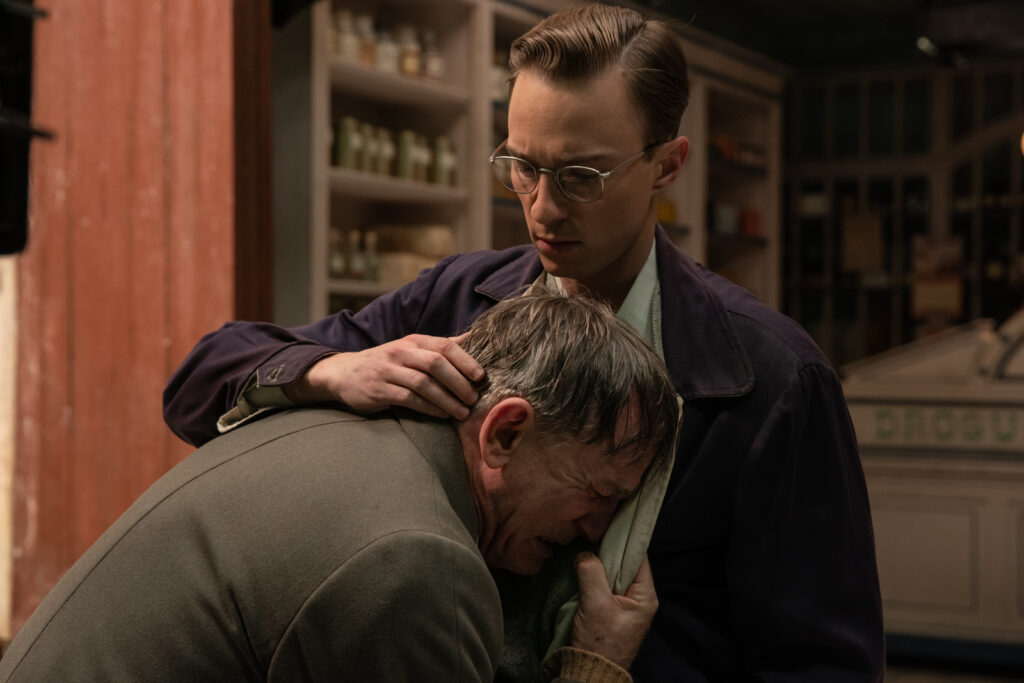
The broken dandy: Burroughs’ style
For Queer’s mid-century costume design, Guadagnino reunites with close friend and frequent collaborator Jonathan Anderson, the Irish-born fashion designer who is the creative director of the Spanish luxury house Loewe.
Queer required a psychological and ephemeral approach to costume design. “Men didn’t keep clothing for long during the 1950s — especially men like William Lee, living the expatriate life in Mexico,” says Anderson. “Queer was about looking at the fetishistic idea of menswear during the mid-century years, which there was a subtlety to.”
While researching historic imagery of Burroughs, Anderson encountered what he calls a certain “undoneness” in the writer’s early period that the designer became enamored of and sought to replicate in Daniel Craig’s wardrobe. “He would undo the top button on a jacket and leave the bottom ones fastened,” says Anderson. “That attitude became paramount when I started working with Daniel because it gave me a sense of how Burroughs perceived clothing and moved within his suits.”
Guadagnino was impressed by Anderson’s knowledge. “He knew the brands and labels of the time and knew that Burroughs was wearing suits off the rack from Sears Roebuck & Company,” says Guadagnino. “Both of us were interested in the icon before he became an icon, and Jonathan worked hard to create an image of Burroughs that didn’t rely on the salesman suit that came to define him in the Beat Era.”
“I saw him as this broken dandy, with his body affecting his clothing to the point where it appears as though it’s worn into him, like a second skin,” says Anderson. “The style of Lee’s garments is ultimately about how he holds his body.”
In contrast to Lee is Allerton’s preppy silhouette of polo shirts and vests with pleated trousers. “I approached Allerton’s clothes as a kind of stylistic barrier because he doesn’t give in to Lee’s advances right away.”
Queer opens nationally on November 27, 2024.





Comments are closed.